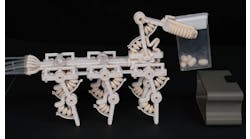In a previous article, New Perspective on Supply Chain Performance, I pointed out that, if we take a whole-system perspective, supply chains consist of both human systems and machine systems. Machine systems dominate discussions of supply chain strategy and execution, and may cause executives to overlook their supply chain's human systems as a priority and substantial opportunity for improving supply chain performance.
For a moment, let's set aside the typical important supply-chain discussions concerning supplier capabilities, logistics, shipping costs, and IT systems in order to consider your supply chain's human systems. Exactly what is a human system and what insight does this perspective give executives for how they can optimize more performance out of their supply chain?
Let me use an example that focuses on the development of a supply chain to illustrate my point. Recently, I was interviewing a regional sales manager for the supply-chain services unit of a major logistics supplier. My questions centered on his assigned objectives and the challenges he faced in their achievement. No question this outfit was providing some fascinating services, however companies that were recently acquired established most of them. When it came to developing new service agreements, this sales manager faced one challenge after another and, more troubling, could not figure out how to get adequate support from headquarters.
What is important to recognize about this situation is that I was talking with a mature, highly capable sales manager in a responsible position with the potential to win or loose millions in new business for his company. It was not some failing on the part of this person that explains why he wasn't making these deals. The source of the problem was elsewhere in this person's (human) work system. In fact, his manager interpreted his expressed concerns about the problem as, well, bellyaching.
After confirming this situation with other sales managers and investigating the deal-approval process, I understood the problem. These large, inherently risk-laden deals require approvals that go up the chain of command to a level removed from field sales concerns and lacking any real incentive to sign-off on the risk. As a result, the field sales managers, and their sales representatives, are blocked essentially from fulfilling their commitments to customers and from achieving their sales objectives. No amount of training, incentive compensation, additional staff, or new services can remove this constraint.
Management can easily overlook the fact that a company's supply chain is primarily a human endeavor. Managers with whom I've talked know this, but beyond the selection of capable people they admit to not knowing what specifically can be done to bring their supply chain's human systems up to a peak level of performance. This is understandable, as the complexity of human systems far exceeds the complexity of the machine systems that often dominate management's attention.
To get some insight into what management can do to improve its human systems, let's clarify what we mean by human system? From an operations perspective, it is most helpful to breakdown human systems into three principal layers of design:
- System context layer or the situation, including the marketplace, industry, enterprise, strategy, process, organization structure, and managerial systems
- System role layer or the function, including its responsibility, tasks, authority, supervision, relationships, facilities, technology, and support systems
- System agent layer or the worker, including his or her personality, behavior, knowledge, ability, and motivation.
The simplest human system we might imagine consists of an individual worker in some role somewhere within an enterprise. Every human system has a purpose, which is to transform inputs into outputs. Everything that has an affect on that throughput is part of the system. Therefore, making sense of human systems entails understanding the interrelationships between the many elements within the system that influence the agent as he or she attempts to perform his or her designated role within a context or specific situation.
Industry's focus on human performance has been limited mostly to the person in the role, leaving untapped the impact on performance of role design and support (i.e., context design), which operations management controls. Both the scholarly research and documented experience demonstrate that these two components of human work systems, not the agent or worker, (a) explain about 80% of performance outcomes, and (b) remain largely under-designed for optimizing human work performance.
Compared to what you imagine is humanly possible, at what level of effectiveness would you say your supply chain's human systems operate? 100%? 80%? 60%? If less than 100%, why do you tolerate the shortfall? What is this shortfall costing you?
In his breakout presentation at IW's SMART/mfg conference to be held June 14-16, in Las Vegas, Pepitone will address how companies can develop-peak performing supply chains.
To learn more about the conference click here.



